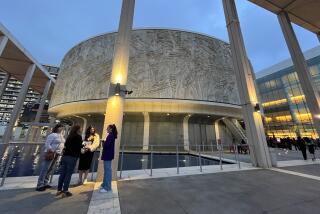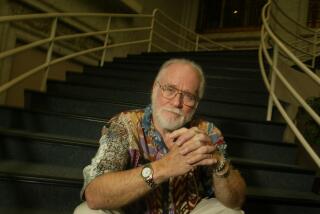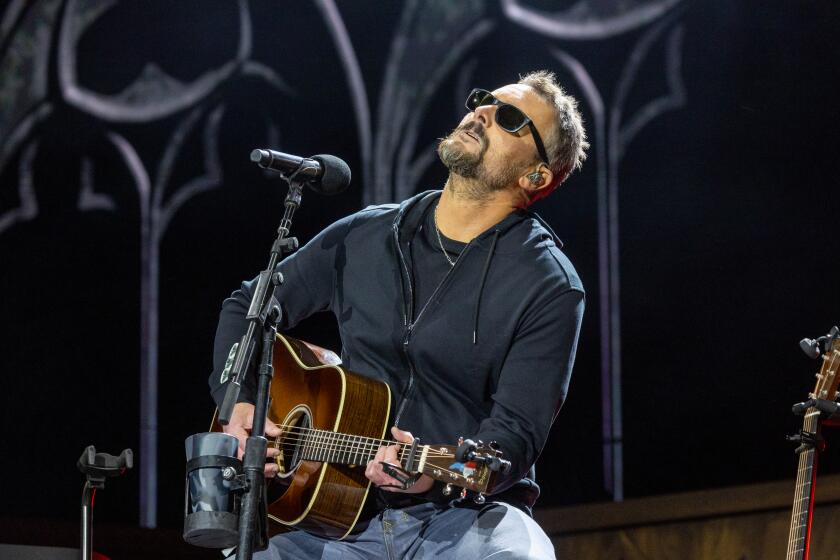Critic’s Notebook: Radar L.A. a glorious convergence of contemporary performance
Radar L.A., the international theater festival of contemporary performance that came to a close Sunday, was part of a glorious convergence of panels, conferences and festivals that put L.A. at the center of the theatrical universe last week. Theater folk from far and wide were milling around REDCAT and the Los Angeles Theatre Center (LATC) as though they were their homes away from home. It was Eli Broad’s vision of downtown as a vibrant cultural nexus come true, except the pedestrian stream was preponderantly bubbly performing arts types rather than modish gallery-hoppers.
Count this inaugural year of Radar L.A. a success, even if the pleasures weren’t to be found in the discovery of mini-masterworks but in fleeting encounters with what can only be described as pure theatricality. The eight shows I sampled offered intermittent delights as well as occasional frustrations. But collectively, they were an avowal of the power of theater to express in stage language what cannot be articulated in any other.
Drama, in short, took a backseat to radical performance. The theater-makers on hand were less interested in producing facsimiles of the world than in setting in motion their own cockeyed universes. Works such as Teatro en el Blanco’s “Neva,” Rude Mechs’ “The Method Gun,” the Company’s “As You Are Now So Once Were We” and CalArts’ Center for New Performance/Poor Dog Group’s “Brewsie and Willie” (which I caught during its pre-Radar run) purposely didn’t provide maps for their audiences. Disorientation was part of the ride. The artists corralled by the festival’s co-directors, Mark Murphy, Diane Rodriguez and Mark Russell, weren’t in the business of doling out nuggets of wisdom. They sought to provide experiences that couldn’t be reduced to sententious sound bites.
As a renewal of theatrical possibility and as an expander of audience sensibility, Radar L.A. is an invaluable addition to the city’s cultural ecology, which is still reeling from the loss of UCLA Live’s International Theatre Festival. As I scurried from one theater to the next at LATC, bumping into acquaintances old and new along the way, I had intimations of the energy that must have coursed through this magnificent building in the thrilling, financially ruinous days when Reza Abdoh was making his harrowing performance collages in the late ‘80s, early ‘90s. And as I listened to the excited din of crowds in the lobbies of REDCAT and the Kirk Douglas Theatre, I couldn’t help reflecting on descriptions I’ve heard of the 1984 Olympic Arts Festival, which apparently buoyed the town with a critical mass of innovative performance.
Because L.A.’s geography is so sprawling, that sense of urban density (in every regard but traffic) is hard to achieve. This is why a festival such as Radar L.A., limited to a period of several days and situated within an easily commutable area, can be so revitalizing, especially when there’s a synergy with other related events, as there was this year with the Theatre Communications Group’s national conference and the Hollywood Fringe Festival, among other goings-on.
The hope of the organizers is to bring Radar L.A. back every other year. Of course, it is unlikely that TCG will be powwowing again in L.A. in 2013, so the festival must rely more on its programming in the future (and I sincerely hope there will be a future) to draw the crowds. The groundbreaking nature of the fare means that much of it will be obscure even for knowledgeable theatergoers. These kinds of offerings cry out for contextualization. The public has had its appetite whetted by this introductory year, but memories fade over a two-year span, and audience cultivation for this sort of challenging, rigorously noncommercial work is always an uphill affair.
What I’ll treasure most from my Radar L.A. theatergoing are the stunning, tightly choreographed finale of “The Method Gun,” in which a fictionalized theater ensemble achieves its long-awaited apotheosis, and the scenes involving the stupendous actresses of “Neva,” the Chilean import built around Chekhov’s widow, Olga Knipper. This latter piece, constructed like a self-fueling theatrical machine, culminates in a cascading monologue of revolutionary fervor that is, in its critique of bourgeoisie stage pretension, unlike anything else I’ve experienced in the theater.
There were plenty of other arresting moments derived from works that were less successful as a whole. The hallucinatory beauty and farcical élan of José Luis Valenzuela’s staging of the Latino Theater Company’s “Solitude” overcame for a time the hurdle of Evelina Fernández’s rambling and overripe melodrama. The prison barracks setup of the Los Angeles Poverty Department’s “State of Incarceration,” a work that would have benefited from more artistic development, allowed audiences and actors to inhabit the shockingly overcrowded reality of California’s penitentiary system. The gorgeous multimedia sorcery of Fleur Elise Noble’s “2 Dimensional Life of Her,” which may not be theater, but so what?, goes a long way toward making the mise-en-scène the star. And Moving Arts’ “The Car Plays: L.A. Stories,” which curiously elicited condescending looks among fellow festival travelers whenever I recommended the bill, introduced a novel form of super close-up acting that was admittedly more intriguing than the playlets.
All told, it would be impossible to attend a handful of these works — and the “5 for $50” flex pass deal made it possible for a diverse crowd to sample widely — without having your definition of theater expanded. Is there really no chance, Radar L.A. chieftains, of bringing this galvanizing event back next year? New York’s Under the Radar Festival is comfortably established as an annual event, and given the rousing welcome its West Coast counterpart just received, Radar L.A. should have a regular place on our calendar as well.
More to Read
The biggest entertainment stories
Get our big stories about Hollywood, film, television, music, arts, culture and more right in your inbox as soon as they publish.
You may occasionally receive promotional content from the Los Angeles Times.







